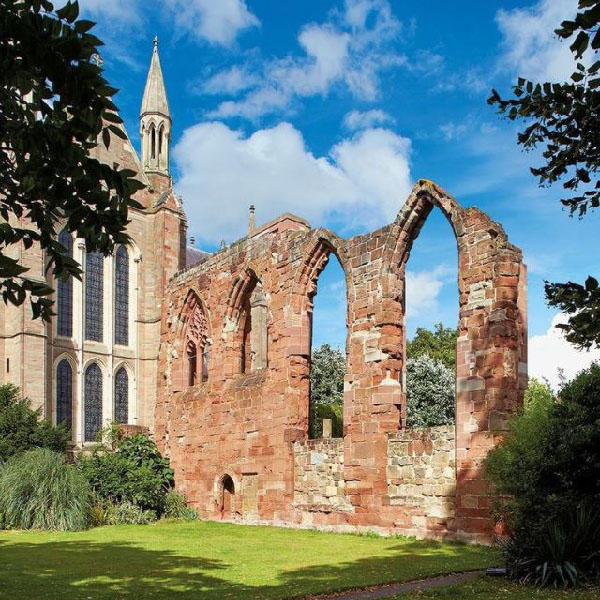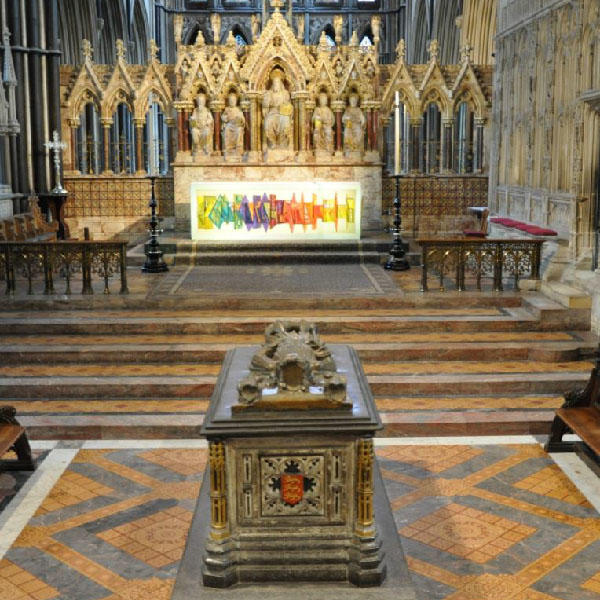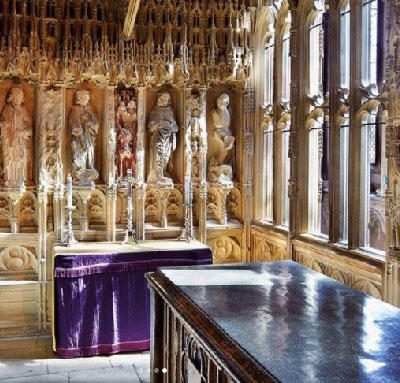Doctor Lucy Arnold is a Lecturer in Contemporary Literature at the University of Worcester. In this Academic Blog she explores the connection between Worcester Cathedral and the novels of Hilary Mantel. Hilary Mantel’s latest novel 'The Mirror and The Light' was published in 2020:
Worcester Cathedral, rising above the banks of the River Severn, dominates the Worcester skyline and shapes the city centre’s aural character as its bourdon bell strikes each hour. As a landmark, it has punctuated my commute, from Foregate Street Station, across the river and uphill to the St John’s campus of the University of Worcester, for nearly two years, wreathed in mist or glowing in early summer sun. As the publication of Hilary Mantel’s The Mirror and The Light approached in 2020, I was drawn inside the building to ask how putting this local landmark into conversation with Mantel’s Tudor novels - particularly the text which introduced her readership to Thomas Cromwell’s England, Wolf Hall - destabilises a perception of the historic building as an incontestable element of the narrative of certain moments in the historical past. My visits revealed how historical fictions and the heritage sites they reference intersect through their accommodation of the gaps in the historical record, the moments when documentary evidence fails and we are thrown back on our own imaginations. Such texts and places have the capacity to put pressure on the dominant narratives of history, to allow us, as visitors and readers, to pose a new set of questions.

‘How lonely it is to die young, to go down into the dark without any company! Maurice St John is not there with him, in his vault at Worcester Cathedral: nor Mr Cromer William Woodall, nor any of the men who heard him say, “Masters, it is a good pastime to have a wife.”’
So observes Cromwell in Wolf Hall, a comment which forges tense connections between novel and place, between literary fiction, architectural fact and historiographic conjecture. Perhaps to a greater degree than other kinds of genre fiction, the historical novel makes claims on our material world and the way we understand it, makes claims on the historical documents we read, and on the heritage sites we visit such as Worcester Cathedral. Moreover, heritage sites, whether places of worship or not, similarly generate relationships to the historical past and the historical dead. We sit where they sat, we touch what they touched – or at least, we may assume we do.

Cromwell’s comment foregrounds Worcester’s most prominent connection to the Tudor world, and to the world of Wolf Hall: it is the final resting place of Prince Arthur Tudor, the great hope of the Tudor dynasty, whose death at the age of fifteen ushered in the reign of Henry VIII, the Henrician Reformation and, tangentially, the unprecedented rise and rise of Thomas Cromwell. Yet if Arthur walks as ‘a ghost [. . .] studious and pale’ in Wolf Hall, a phantom who appears in dreams to make cryptic claims on the future, we might assume that stepping into his chantry chapel at Worcester would offer a more tangible and unambiguous connection to Arthur’s story, so frequently abridged or forgotten, occulted by his brother’s more famous narrative.
But as Steven Gunn and Linda Monckton observe in their book Arthur Tudor, Prince of Wales: Life, Death and Commemoration, Arthur’s chantry poses a number of ‘problems of interpretation’. No records exist pertaining to the commissioning of building of the tomb, the labour or costs involved or the extent of royal involvement in its erection. How long the chapel took to build, whether it has always stood in its current position – all of these details remain in question, none more so than the location of Arthur’s body itself. The position of the chantry encourages the untrained eye to assume that Arthur’s bones repose either in his box tomb itself (as is the case for his royal companion in the cathedral, King John) or else beneath it. However, archaeological surveys undertaken in 2011 using ground penetrating radar revealed a large chamber off to one side of the tomb which may, or may not, contain Arthur’s remains. The material history which relates to Arthur, far from offering a straightforwardly graspable account of his burial and memorialisation, instead continues both to provoke and resist interpretation.

To grasp the challenges to interpretation that this structure poses to the visitor, and the way that resistance mirrors other resistances present in Mantel’s account of the Tudor world and of Prince Arthur’s haunting legacy in particular, it is necessary to examine the architecture of the tomb in detail. In Wolf Hall, Mantel depicts the ruthless process of architectural editing commissioned by Anne Boleyn as she seeks to eradicate any material trace of her forebear, Katherine of Aragon: ‘[Anne] is planning to commandeer Katherine’s royal barge [. . .] and have the device “H&K” burned away, all Katherine’s badges obliterated.’ An examination of Prince Arthur’s chantry, however, reveals that the historical Anne’s efforts were not universally successful. High on the walls of the chapel are carved pomegranates, Katherine of Aragon’s emblem. Meanwhile, the chamber conjectured by archaeologists to contain Arthur’s remains is much larger than necessary to contain one body, prompting speculation from historians such as Mark Duffy that the chamber may have originally been intended to allow Katherine to be laid to rest next to her husband.
The stone pomegranates and empty chamber continue to attest to a narrative which never came to fruition, to uphold Arthur and Katherine’s marriage as licit, to maintain Katherine’s presence in the Tudor narrative. They speak to the provisional quality of history, an awareness of which saturates Wolf Hall. In a passage which echoes the inscription on the historical Arthur’s tomb, Mantel states of the forgotten prince: ‘If he were alive now, he would be King of England. His younger brother Henry would likely be Archbishop of Canterbury and would not (at least we devoutly hope not) be in pursuit of a woman of whom the Cardinal hears nothing good. [. . .] Beneath every history, another history.’
Author Bio: Lucy Arnold is a lecturer in English Literature (Contemporary) at the University of Worcester. Her book Reading Hilary Mantel: Haunted Decades as published with Bloomsbury in 2019
Twitter: @spectresof
Photo Credit: Images have been provided by Worcester Cathedral
Instagram: @worcestercathedral